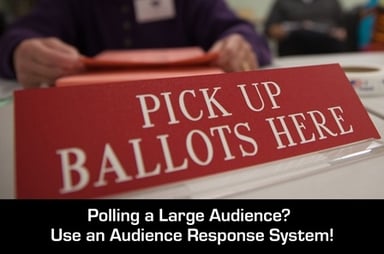
Large audience voting in public meetings can be long, arduous, and cumbersome. There are many different methods of voting and each presents unique challenges. The four most significant issues they all share are time constraints, privacy concerns, voting security problems, and count inaccuracies.
However, by investing in an audience response system, the challenges associated with standard voting practices are no longer an issue. There are 4 important reasons to invest in an electronic voting system for audience polling:
- Electronic voting is far more accurate than standard voting practices. Electronic voting requires the use of handheld interactive keypads by everyone in attendance in order to cast a vote. These keypads transmit a unique ID number on each device which is assigned to only 1 individual. In addition, the keypads used with this voting software only count the last vote cast on the device during the voting period. This eliminates tabulation errors or a person casting more than one vote on a single issue. It also eliminates the uncertainty of a voice or hand vote that is not decipherable.
- Electronic voting systems maintain privacy throughout the voting process. With standard voting procedures, people are required to stand, raise their hand, or use their voice in order to cast a vote. With electronic voting, participants can cast their votes without fear of reprisal if votes are disclosed. These systems even allow for online voting! While watching a live video feed of the proceedings, a participant can cast their vote from home on their desktop, laptop, or use a mobile device from anywhere which means you can bring your own device to the meeting and use it to cast your votes. In addition, electronic voting ensures that all votes are genuine and indicate the true preferences of the participants. This also helps to create higher attendance rates as well as higher validity since voters are more likely to cast votes based on their true feelings.
- Electronic voting systems are secure. Each vote is transmitted via encrypted wireless transmission and confirmed personally to each voter. Radio signals are encrypted using special proprietary algorithms. Every transmission uses frequency hopping spread spectrum protocols that make it very hard to hack the system or interfere with it.
- Electronic voting with wireless keypads is fast. Electronic voting systems collect data from the participants every 3 seconds. When an issue is presented to be voted on, all participants typically respond within 20 to 30 seconds. After the meeting is over, electronic voting systems allow for an instant report of results to be viewed and published.
Standard voting procedures typically require large amounts of time dedicated to counting and collecting votes. Not only does this increase the probability of error but it also reduces the amount of time that can be spent on the issues being debated.
With less of an opportunity for error, and the added benefits of privacy and more transparency when displaying the overall results to the public, electronic voting will leave more time for the important matters and issues at hand.
Several hardware and software solutions for electronic voting are available by way of an audience response system rental or purchase. ARS systems for electronic voting can scale from 10 people to as many as 15,000 voters in a single venue. You can learn more about the different configurations for public meetings by clicking the button below.


